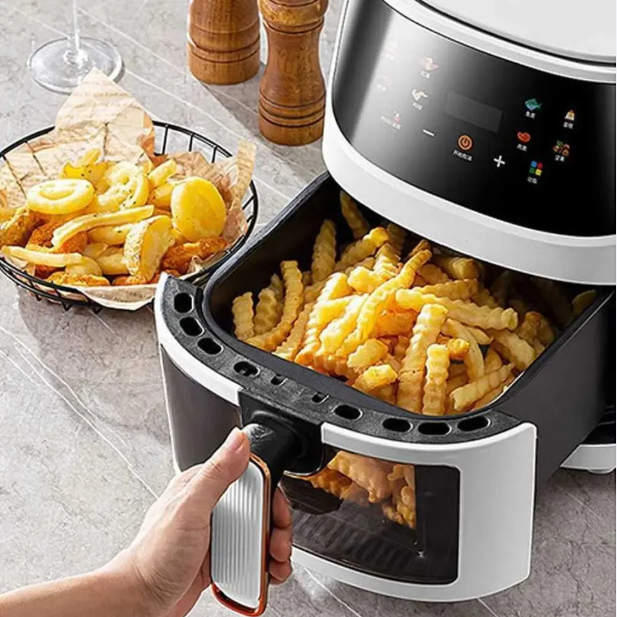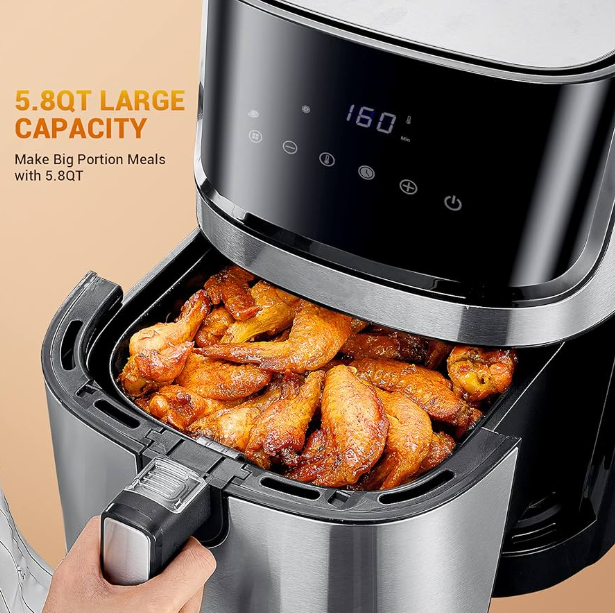Hello, fellow food lovers! Chef Airkit here, straight from the Airkit Home test kitchen. I get asked a ton of questions about our favorite countertop appliance, but one pops up more than any other, especially with energy bills on everyone’s mind: Are Air Fryers Energy Efficient? You’ve seen them everywhere, you’ve heard the hype about getting that perfect crispy crunch without the deep-fried guilt, but does this kitchen wizardry actually save you money on your electricity bill?
Let’s cut through the noise. The short answer is a resounding yes, for most everyday cooking tasks. But as a chef, I know the best results come from understanding your tools. So, grab a cup of tea, and let’s break down exactly how an air fryer can be your wallet’s new best friend, and when your trusty old oven still has its place.

How Do Air Fryers Work Their Magic Anyway?
Before we talk efficiency, we need to understand the science. An air fryer isn’t actually a “fryer” at all. Think of it as a small, high-powered convection oven. Here’s the simple breakdown:
- A Heating Element: Located at the top, this gets hot, really hot.
- A Powerful Fan: This is the secret sauce. It circulates that superheated air rapidly and evenly all around your food in the compact
air fryer basket. - The Result: This intense, circulating heat cooks food much faster than a traditional oven and creates an incredible crispy exterior, mimicking the results of deep-frying. This process is what food nerds like me call the Maillard reaction, and it’s responsible for that delicious golden-brown color and flavor.
Because the cooking chamber is so much smaller than a conventional oven, it heats up in a flash. That’s the first clue to its efficiency.
The Big Question: Are Air Fryers More Energy Efficient Than Ovens?
Yes, in most common cooking scenarios, air fryers are significantly more energy-efficient than conventional ovens. The savings come down to two key factors: time and size. A conventional oven is a huge, insulated box that can take 10-15 minutes just to preheat. An air fryer, on the other hand, is ready to go in 2-3 minutes, if it needs preheating at all.
Let’s look at the core reasons why your air fryer wins the energy race for daily meals:
- Faster Preheating: An oven needs to heat a large empty space. An air fryer heats a tiny space. My Airkit Home model is ready to cook crispy fries before my big oven has even reached 200°C. That’s a huge energy save right from the start.
- Shorter Cooking Times: That rapid air circulation we talked about? It slashes cooking times. Chicken wings that take 45 minutes in the oven are perfectly crispy in about 20-25 minutes in the air fryer. Roasted vegetables? Cut the time in half. Less time on means less energy used.
- Lower Wattage: While it varies by model, most air fryers run between 1,400 and 1,700 watts. Conventional ovens can easily pull 2,000 to 5,000 watts, especially during the preheating phase. Even though they’re on for a shorter time, air fryers simply draw less power per minute.
I remember the first time I swapped my oven for an air fryer to make roasted broccoli. I was skeptical, but the results—and the time saved—blew me away. What took nearly 40 minutes in the oven was done in 15, and it was crispier. That was my “aha!” moment.
Let’s Talk Numbers: The Real Cost Savings
Okay, let’s get practical. While exact savings depend on your appliance’s wattage and local electricity rates, we can look at a simple example.
Imagine you’re cooking a couple of chicken breasts.
- Conventional Oven:
- Preheat time: 10 minutes
- Cook time: 25 minutes
- Total run time: 35 minutes
- Average power usage: ~2,400W
- Air Fryer (e.g., Airkit Home):
- Preheat time: 2 minutes
- Cook time: 18 minutes
- Total run time: 20 minutes
- Average power usage: ~1,500W
Without even getting into complicated math, you can see the air fryer runs for almost half the time while using significantly less power per minute. Over a week, a month, or a year of making weeknight dinners, those savings add up substantially.
As kitchen appliance expert, Sarah Jenkins, notes, “The efficiency of an air fryer lies in its targeted approach. It doesn’t waste energy heating a large, empty cavity. It delivers intense heat exactly where it’s needed, which is a game-changer for small to medium-sized households.”
When Your Conventional Oven is Still the Star Player
As much as I adore my air fryer, it’s not a complete oven replacement. Being an honest chef means telling you when to use the right tool for the job. Here are a few times you should stick with your conventional oven:
- Cooking for a Crowd: Roasting a large 5kg turkey or baking a massive lasagna for a family gathering? The oven’s size and capacity are unbeatable. You simply can’t fit that in an air fryer basket.
- Batch Baking: If you’re baking dozens of cookies or multiple loaves of bread, the oven allows you to do it all at once on multiple racks.
- Wet Batters: Foods with a very liquid batter (like a tempura) don’t work well. The fan will blow the wet batter right off the food before it has a chance to set.
- Large, Delicate Cakes: While you can bake small cakes in an air fryer, a large, delicate sponge cake needs the gentle, even heat of a conventional oven to rise properly without the top browning too quickly.
Think of it this way: the air fryer is your go-to for speedy, crispy, and efficient daily cooking, while the oven is your workhorse for large-format meals and specific baking projects.
Pro Tips to Maximize Your Air Fryer’s Energy Efficiency
Ready to become an energy-saving pro? Here are my top tips, straight from the Airkit Home kitchen, to get the most out of your appliance:
- Don’t Overcrowd the Basket: This is the number one rule of air frying. Food needs space for the hot air to circulate. Overcrowding blocks airflow, leading to longer cooking times and soggy results, which defeats the purpose. Cook in batches if you have to; it’s still faster and more efficient than using the oven.
- Cut Food Uniformly: Cutting your ingredients into similar-sized pieces ensures everything cooks evenly and at the same rate. No need to extend the cooking time (and energy use) just for a few stubborn, larger pieces.
- Shake it Up: For small items like fries or chicken nuggets, give the basket a good shake halfway through cooking. This redistributes the food, exposing all sides to the hot air for faster, crispier, and more even results.
- Keep It Clean: A clean air fryer is an efficient air fryer. Built-up grease and food debris on the heating element or in the basket can impede airflow and make your appliance work harder than it needs to. Check out our [internal link to a guide on cleaning your air fryer] for easy tips.

Frequently Asked Questions
Let’s tackle some of the most common questions I hear about air fryer energy use.
How much electricity does an air fryer use in an hour?
An average air fryer uses between 1.4 and 1.7 kilowatt-hours (kWh) if run continuously for a full hour. However, most recipes only require 15-25 minutes of cooking, so your actual usage per meal is much lower, typically around 0.4-0.7 kWh.
Is an air fryer cheaper to run than a microwave?
It’s a close call. Microwaves are slightly more energy-efficient for simple reheating, as they use around 700-1,300 watts. However, an air fryer is a far more versatile cooking tool that can roast, bake, and “fry,” producing results a microwave can’t. For cooking rather than just reheating, the air fryer often provides better value for its energy use.
Does using an air fryer increase my electricity bill?
On the contrary, if you use it to replace your main oven for smaller meals, it will almost certainly decrease your electricity bill. The combination of lower wattage and significantly shorter cooking times leads to overall energy savings.
Are larger air fryers less energy-efficient?
Not necessarily. While a larger air fryer may have a slightly higher wattage, it also allows you to cook more food at once, which can be more efficient than running a smaller model for two separate batches. The key is to choose a size that matches your household’s needs.
Can an air fryer replace my oven completely?
For a small household or a single person, it’s possible it could handle 90% of your cooking needs. However, for most families, an air fryer works best as a powerful, efficient companion to a conventional oven, not a complete replacement.
The Final Verdict
So, are Air Fryers energy efficient? Absolutely. They are a fantastic tool for the modern kitchen, saving you time, reducing your energy consumption, and delivering delicious, crispy food with a fraction of the oil. By understanding how to use it best—for your daily chicken, vegetables, potatoes, and reheated pizza—you’re not just making a choice for a healthier meal; you’re making a smarter choice for your wallet and the planet.
Now that you have the chef-approved facts, it’s time to put that knowledge to use. Go ahead, fire up that air fryer with confidence, and enjoy your next quick, crispy, and wonderfully efficient meal. What will you be making first?